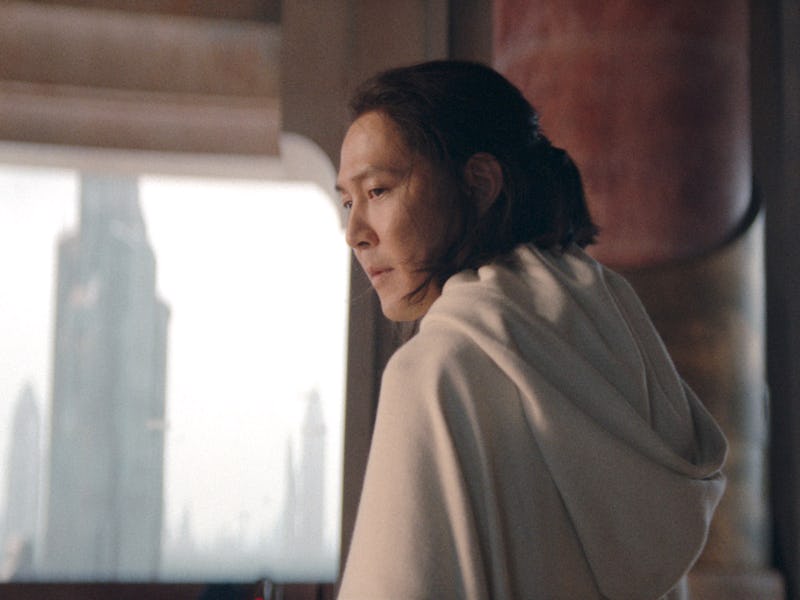The Acolyte Just Rewrote Everything We Thought We Knew About the Jedi High Council
Keep it in your department.

When Qui-Gon Jinn and Obi-Wan Kenobi were sent on a mission to deal with the Trade Federation on Naboo, they were technically operating as agents of the Republic. But after a topsy-turvy journey brought them to Tatooine, the Master and Padawan returned to Coruscant and reported directly to the Jedi High Council. So who do the Jedi answer to? Themselves? Or the Republic? The answer seems to be both, but within that slippery pluralism, the most influential Jedi of all may not wield the most practical power.
In the fourth episode of The Acolyte, a very specific exchange between Vernestra Rwoh (Rebecca Henderson) and Master Sol (Lee Jung-jae) reveals a new layer to official Jedi business, and why the Jedi might exclude the highest members of the Order from certain problems.
Most of the Jedi we see in The Acolyte aren’t near the top of the chain of command.
In The Acolyte Episode 4, Sol, Jecki, Yord, Osha, and a handful of backup Jedi are dispatched to the Jungle planet of Shofar to find the Wookiee Jedi Kelnacca. Their mission is to warn Kelnacca, while hopefully drawing out Mae and discovering who her mysterious master is. The team gets their wish, as the episode’s final moments feature the emergence of this mysterious Sith-like figure. But the funny thing is, the Jedi High Council has no idea all those Jedi are even there.
Before the squad heads to Shofar, Vernestra makes it very clear why the High Council will not be informed of what’s going on. When someone says, “We must inform the High Council,” Vernestra shuts them down, saying, “The High Council would be obliged to inform the senate… a scandal like this would inspire fear and mistrust.”
The scandal is a big one. Former Jedi Padawan Osha has been accused of slaying two Jedi Masters, her twin sister Mae is seemingly the true party responsible, both sisters were possibly conceived with the Force itself by Force-witches, and Mae has been trained for years by a dark master of the Jedi arts. These are all things the High Council should be made aware of, so the fact our mid-level Jedi are keeping it under wraps is telling.
In a sense, the Jedi managed by Vernestra in The Acolyte are their own kind of council, or at least a kind of Jedi mystery-solving squad. But this is very different from how the Jedi operate in The Phantom Menace a century later. When Qui-Gon encounters the Sith Lord Darth Maul, he tells the High Council immediately.
Clearly, the situation and stakes in The Acolyte are different. In The Phantom Menace, you get the sense that Mace Windu and Yoda don’t have to inform anyone in the Republic about this rumor of a Sith Lord. They simply have Qui-Gon check it out. But in The Acolyte, the scandal involves a former Jedi being accused of murdering Jedi in response to a scandal in which the Jedi caused several fatalities on a planet not part of the Republic. Had Qui-Gon Jinn been accused of murder, maybe the High Council would have had to inform the Senate.
Vernestra Rwoh is an important Jedi, but she’s not the boss.
Still, in the prequels, we get the sense that the Jedi got their marching orders from the High Council, and no one in the Order made any big decisions without the Council’s decrees. That setup was reinforced in The Clone Wars, where Jedi only seemed to make their own decisions on the battlefield. But, here, in a time of peace, The Acolyte has revealed a lack of true hierarchy. Vernestra’s authority over the other Jedi characters mostly seems derived from the fact Vernestra is their elder.
This suggests that seniority plays a huge role in how and why certain Jedi are and aren’t allowed to do certain things. The High Council, at least in this era, isn’t the only authority that governs the Jedi’s internal affairs. Instead, The Acolyte has made it clear that many of the decisions that will shape the future of the Jedi are made on the fly by Jedi middle managers. We have four episodes left to learn whether such an informal structure is a good thing.